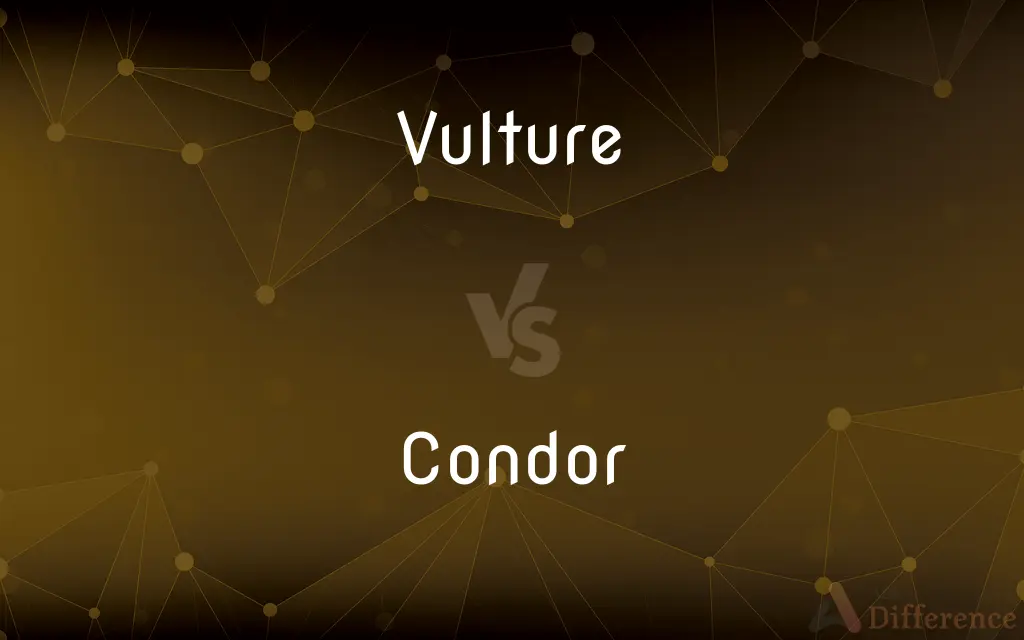Vulture vs. Condor — What's the Difference?
Edited by Tayyaba Rehman — By Urooj Arif — Updated on April 8, 2024
Vultures are scavenging birds found worldwide, known for their role in ecosystems, while condors, a subset of vultures, are among the largest flying land birds in the Western Hemisphere.

Difference Between Vulture and Condor
Table of Contents
ADVERTISEMENT
Key Differences
Vultures encompass a wide variety of scavenging birds belonging to two distinct families: the New World vultures (found in the Americas) and the Old World vultures (found in Africa, Europe, and Asia). They play a crucial role in their ecosystems by consuming dead animal matter. On the other hand, condors represent a smaller, specific group within the New World vultures, consisting primarily of two species: the Andean condor and the California condor, known for their impressive wingspans and significant cultural symbolism.
While all condors are vultures, not all vultures are condors. The distinction lies primarily in their size, habitat, and specific species characteristics. Condors are among the largest of the vultures, with the Andean condor having one of the widest wingspans of any land bird. In contrast, vulture species vary widely in size and appearance, from the relatively small Egyptian vulture to the larger griffon vultures of the Old World.
Vultures are adapted to a scavenging lifestyle, with sharp beaks and strong stomach acids to consume carrion efficiently. They have bald heads, which are thought to be an adaptation for hygiene, preventing feather fouling during feeding. Condors share these adaptations but are often highlighted for their remarkable soaring ability, using thermal updrafts to travel vast distances in search of food without expending much energy.
The conservation status of vultures and condors varies by species, with many facing threats from habitat loss, poisoning, and persecution. Condors, both the Andean and the California, have been the focus of significant conservation efforts due to their near extinction in the wild. The California condor, in particular, was brought back from the brink of extinction through captive breeding programs and is often cited as a conservation success story.
Despite their often negative portrayal in popular culture, vultures, including condors, provide essential ecosystem services by disposing of carrion, which helps prevent the spread of diseases. Their presence is indicative of a healthy environment, and their decline is of concern for ecosystems worldwide.
ADVERTISEMENT
Comparison Chart
Family
Accipitridae (Old World) and Cathartidae (New World)
A subset of Cathartidae (New World vultures)
Distribution
Worldwide, except for Antarctica and Oceania
Western Hemisphere, specifically the Americas
Size & Appearance
Varied, from small to large with bald heads
Among the largest flying land birds with extensive wingspans
Diet
Scavengers, feeding on carrion
Scavengers, specializing in large carcasses
Conservation
Many species are threatened or endangered
Both the Andean and California condors are focus of conservation efforts
Compare with Definitions
Vulture
Scavenging birds of prey found worldwide, known for feeding on dead animals.
The vulture circled above the savannah.
Condor
Symbolize freedom and power in many indigenous cultures.
The condor is a sacred bird in many South American traditions.
Vulture
Have bald heads and strong stomach acids for consuming carrion.
Vultures have adaptations that make them excellent scavengers.
Condor
Exceptional fliers, using thermal updrafts to glide.
Condors can soar for hours without flapping their wings.
Vulture
Help control disease spread by cleaning up carrion.
Vultures play a crucial role in maintaining ecosystem health.
Condor
A specific group of large New World vultures, including the Andean and California condors.
The Andean condor is revered in South American cultures.
Vulture
Many species face threats from poisoning and habitat loss.
Conservationists are working to protect vulture habitats.
Condor
Known for their massive wingspans, among the largest of any land bird.
The wingspan of a condor can reach over 3 meters.
Vulture
Often unfairly viewed negatively, despite their ecological importance.
Despite myths, vultures are vital for environmental balance.
Condor
The California condor has been brought back from near extinction.
Captive breeding programs have helped increase condor populations.
Vulture
A vulture is a bird of prey that scavenges on carrion. There are 23 extant species of vulture (including Condors).
Condor
Condor is the common name for two species of New World vultures, each in a monotypic genus. The name derives from the Quechua kuntur.
Vulture
Any of various large birds of prey characteristically having dark plumage and a featherless head and neck and generally feeding on carrion. Species found in the Americas are in the family Cathartidae, and those found in Eurasia and Africa are in the family Accipitridae.
Condor
A very large New World vulture with a bare head and mainly black plumage, living in mountainous country and spending much time soaring on massive outstretched wings.
Vulture
A person of a rapacious, predatory, or profiteering nature.
Condor
Either of two New World vultures, Vultur gryphus of the Andes or Gymnogyps californianus, a nearly extinct vulture of the mountains of California, having a bare head and neck and dull black plumage containing variable amounts of white. With a wingspan of about 3 meters (10 feet), they are among the largest birds in the world.
Vulture
Any of several carrion-eating birds of the families Accipitridae and Cathartidae.
Condor
A gold coin of some South American countries bearing the figure of one of these vultures.
Vulture
A person who profits from the suffering of others.
Within ten minutes of the accident, the vultures appeared and were organizing lawsuits.
Condor
Either of two New World vultures, Vultur gryphus of the Andes or Gymnogyps californianus, a nearly extinct vulture of the mountains of California.
Vulture
To circle around one's target as if one were a vulture.
Rudy vultured when asking the girl out.
Condor
A gold coin of some South American countries bearing the figure of one of these vultures.
Vulture
(obsolete) ravenous; rapacious
Condor
An Argentinian short range ballistic missile.
Vulture
Any one of numerous species of rapacious birds belonging to Vultur, Cathartes, Catharista, and various other genera of the family Vulturidæ.
Condor
(golf) The completion of a hole four strokes under par (a quadruple birdie, triple eagle, or double albatross).
Vulture
Any of various large diurnal birds of prey having naked heads and weak claws and feeding chiefly on carrion
Condor
(finance) A combination of four options of the same type at four strike prices, giving limited profit and limited risk.
Vulture
Someone who attacks in search of booty
Condor
A very large bird of the Vulture family (Sarcorhamphus gryphus), found in the most elevated parts of the Andes.
Condor
The California vulture (Gymnogyps californianus), also called California condor.
Condor
A gold coin of Chile, bearing the figure of a condor, and equal to twenty pesos. It contains 10.98356 grams of gold, and is equivalent to about $7.29. Called also colon.
Condor
A gold coin of Colombia equivalent to about $9.65. It is no longer coined.
Condor
Largest flying birds in the western hemisphere
Common Curiosities
Are all vultures endangered?
Not all, but many vulture species face various degrees of threat from human activities.
Can vultures and condors feed on fresh meat?
While they prefer carrion, they can eat fresh meat if necessary, but their specialization is in scavenging.
What distinguishes a condor from other vultures?
Condors are distinguished by their size and are specifically New World vultures.
Why are vultures' heads bald?
The bald head helps maintain hygiene, preventing feathers from getting soiled while feeding on carrion.
How have conservation efforts impacted the California condor?
Captive breeding and reintroduction programs have significantly helped their numbers recover.
What is the largest vulture species?
The Andean condor is considered one of the largest due to its wingspan.
How do vultures contribute to disease control?
By consuming dead animals, they help limit the populations of disease-carrying scavengers.
What are the main threats to vultures and condors?
Poisoning, habitat loss, and persecution are among the primary threats.
How long can condors live?
Condors can live for 50 years or more in the wild and in captivity.
How do vultures find their food?
Vultures have excellent sight and smell, which help them locate carrion over large distances.
Why are vultures important to the environment?
They help prevent the spread of diseases by consuming dead animals.
What challenges do conservationists face in protecting vultures and condors?
Addressing the root causes of decline, such as poisoning and habitat destruction, remains a challenge.
What is being done to ensure the survival of these species?
Efforts include habitat protection, anti-poisoning campaigns, and breeding programs to bolster populations.
Are condors found outside the Americas?
No, condors are native to the Americas, specifically the Andean region and California.
What's the difference in the diets of vultures and condors?
Both primarily feed on carrion, but condors are adapted to handle larger carcasses.
Share Your Discovery

Previous Comparison
Amicable vs. Quick
Next Comparison
Purple vs. CrimsonAuthor Spotlight
Written by
Urooj ArifUrooj is a skilled content writer at Ask Difference, known for her exceptional ability to simplify complex topics into engaging and informative content. With a passion for research and a flair for clear, concise writing, she consistently delivers articles that resonate with our diverse audience.
Edited by
Tayyaba RehmanTayyaba Rehman is a distinguished writer, currently serving as a primary contributor to askdifference.com. As a researcher in semantics and etymology, Tayyaba's passion for the complexity of languages and their distinctions has found a perfect home on the platform. Tayyaba delves into the intricacies of language, distinguishing between commonly confused words and phrases, thereby providing clarity for readers worldwide.
















































